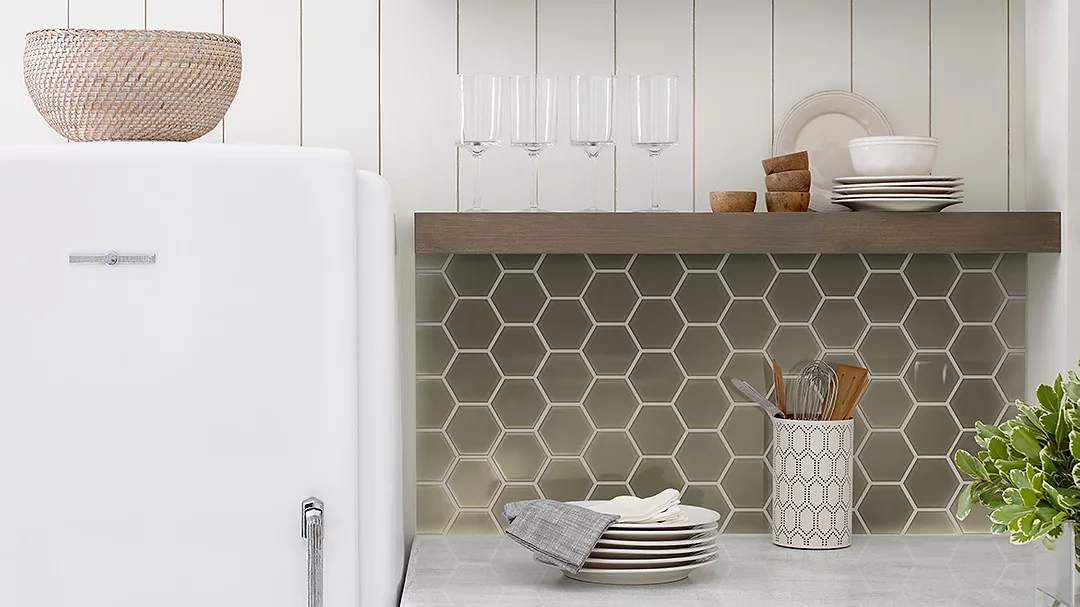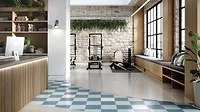2024 Builder Trends in Flooring

RevWood laminated wood flooring blends innovation and craftsmanship, providing natural wood visuals without the maintenance.
Photo: Mohawk

EverStrand is Mohawk’s premium polyester carpet, made from recycled water bottles.
Photo: Mohawk.

Dwell resilient vinyl flooring in Cozy Taupe.
Photo: Shaw Floors.

Inspired by travertine stone, Calligo embodies the natural essence of stone with the convenience and longevity of tile.
Photo: Daltile.

Two new glue-down LVT products, American Charm 6, and American Charm 12, are produced and are geared toward the multi-family/light commercial sectors.
Photo: Armstrong Flooring.

Anderson Tuftex Grand Estate Hardwood in Somerton Castle.
Photo: Anderson Tuftex.

The Ascendant hexagon mosaic is designed to mimic the natural textures, like quarried slate, travertine and limestone.
Photo: Shaw Floors.
With interest rates expected to decline this year, more consumers will have the opportunity to buy or build new homes—a nice change from what the builder market experienced the last few years. With it comes a bevy of new flooring options from manufacturers aimed to help ease supply chains, increase durability and amplify style within a tighter price point.
“With 2024 also being an election year, potential home buyers might stand to wait and see where the economy settles before making large investments,” said Elizabeth Hurley, senior vice president-strategic accounts, Shaw Residential.
New home construction is forecast to increase 4.7% this year according to the National Association of Home Builders (NAHB), and although there are headwinds, the lack of national inventory will fuel a robust year for the builder market.
“Housing is underbuilt, the housing stock is getting older, the population is growing faster than the new structures are getting put in,” said AHF Products President and CEO Brian Carson. “I believe that the industry is going to have a five, six, seven-year good run here.”
A lack of affordable housing across the nation amplifies the need for attainable new construction homes and single-family built-to-rent communities. Homes are getting smaller and builders need to pack in more features with less.
Speculative homes and custom homes are sourcing different materials. Builders want the best looking products at affordable price points. Looking at current interest rates, buyers need to stay within budget on selections.
“Most spec homes will feature less variety in selections and safer visuals to appeal to as many potential buyers as possible,” Hurley said. “On the other hand, someone who is able to select all their finishes will typically expect to see a more expanded offering to choose from.”
Regionally, there are more similarities across different regions than in the past thanks to our collective viewing of social media and television.
“We do still see the most on trend visuals centered on West Coast with those gorgeous light/airy vibes first and making their way across,” Hurley said. “We still see some that lean toward more traditional styles in certain areas in the Midwest vs other areas of the country.”
No matter the prices point, however, consumers want on-trend color tones. Buyers have a preference for medium-light tones for wood visuals in hardwood, luxury vinyl plank and tile, and builders and designers are requesting visuals that align with this preference.
Builders and buyers also want affordable flooring products designed to perform. Luxury vinyl plank has gained popularity over the years as a stylish, durable option. Carpet is a popular option for secondary spaces. It answers consumers’ need for a sense of comfort and warmth into the home, while staying within budget. Carpet trends are leaning towards a more pulled-down texture and small-scale patterns.
While colors have shifted from shades of gray to the taupe and beige color family, there is a movement to more personalization. In turn, we’re seeing emphasis on artisanal touches with handcrafted goods to help create that personalized space.
“People want to feel more comfortable in their homes – more color, pattern – and personal style in general,” Hurley said.
“People want to feel more comfortable in their homes – more color, pattern – and personal style in general.”
– Elizabeth Hurley, senior vice president-strategic accounts, Shaw Residential
For example, trending tile design features more color and tactility for a textured look and feel. Perfectly imperfect is also a popular mindset: Zellige tiles, organic lines and more handcrafted-looking styles are trending.
Buyers are also becoming more environmentally conscious when making their product decisions.
Shaw’s recent flooring launches reflect the prevalent trends. The hardwood and luxury vinyl planks feature elevated visuals and warmer color tones. Wider and longer planks are more visually appealing throughout open floor plans. Still trending, luxury vinyl gives buyers options for durability and easy maintenance. Tile selections feature brighter, bolder colors to appeal to personal preference and individuality. Cabinet colors are featuring colors like “Pistachio” and more mid-tone beiges.
Mohawk Builder + Multifamily is focused on building a diverse portfolio of carpet, laminated wood and resilient flooring to create more sustainable homes.
Made with 100% recycled plastic using Mohawk’s Continuum process, EverStrand is Mohawk’s premium polyester carpet, made from recycled water bottles, which features 11 new styles featuring refreshed color lines, textural patterns and solution-dyed cut piles. RevWood laminated wood flooring blends innovation and craftsmanship, providing natural wood visuals without the maintenance. RevWood is made domestically and sustainably, taking carbon out of the atmosphere and storing it in durable flooring. PureTech is a new product in resilient flooring for builders made with 70% recycled content and Mohawk’s WetProtect technology, PureTech is planet-friendly and waterproof for customers who want a beautiful, high-performing floor. PureTech is PVC-free and has an 80% organic, renewable core.
Home Builder Outlook
As the housing industry celebrated New Homes Month in April, builders continued to respond to buyer preferences by constructing smaller homes to place homeownership within reach for more families planning to buy a home this year.
A National Association of Home Builders (NAHB) analysis found that new homes built in 2023 reached their smallest median size in 13 years.
“Homeownership remains a goal for families who are eager to put down roots and have a place to call their own,” said NAHB Chairman Carl Harris, a custom home builder from Wichita, Kansas. “Our nation’s builders are meeting the moment by finding solutions in home construction to allow for more individuals to purchase a home.”
More than a third (38%) of builders say they built smaller homes in 2023, and more than a quarter (26%) plan to construct even smaller this year, according to NAHB. According to NAHB’s latest What Home Buyers Really Want study, there has been a downward shift in buyer preferences for home size in the last 20 years. In 2003, the typical buyer wanted 2,260 square feet; now, that number is 2,067 square feet.
Data from the U.S. Census Bureau confirm new homes have been shrinking for nearly a decade. The average size of new homes built in 2023 fell to 2,411 square feet, the smallest since 2010. The drop was a continuation in a downward trend that began in 2015. The only year that saw home size increase during this period was 2021, due to the pandemic-induced desire for additional space to work/study from home and the low interest rate environment that allowed buyers to purchase those bigger homes.
More than one-third of builders cut home prices in 2023. NAHB expects builders to continue offering smaller homes and more affordable designs as housing affordability remains a barrier to homeownership. Yet builders face supply-side challenges that continue to increase the cost of constructing homes, such as the scarcity of buildable lots, lack of skilled labor and restrictive codes. The median price of new homes in 2023 was $428,200, down 6% from 2022.
“Boosting the nation’s housing supply is key to improving housing affordability,” said Harris. “The residential construction industry is committed to keeping the cost of housing at the forefront of the national agenda and is working with all levels of government and both sides of the aisle so more Americans can achieve the dream of homeownership.”
A lack of existing inventory that continues to drive buyers to new home construction, coupled with strong demand and mortgage rates below last fall’s cycle peak is pushing builder sentiment.
“Buyer demand remains brisk and we expect more consumers to jump off the sidelines and into the marketplace if mortgage rates continue to fall later this year,” Harris said. “But even though there is strong pent-up demand, builders continue to face several supply-side challenges, including a scarcity of buildable lots and skilled labor, and new restrictive codes that continue to increase the cost of building homes.”
“With the Federal Reserve expected to announce future rate cuts in the second half of 2024, lower financing costs will draw many prospective buyers into the market,” said NAHB Chief Economist Robert Dietz. “However, as home building activity picks up, builders will likely grapple with rising material prices, particularly for lumber.”
Looking for a reprint of this article?
From high-res PDFs to custom plaques, order your copy today!



